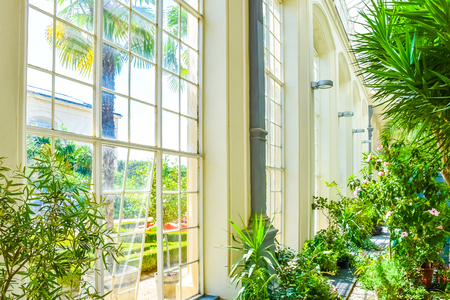1. Introduction: The Allure of Glass Spaces
Conservatories and orangeries have long held a special place in the hearts of British homeowners, captivating generations with their graceful architecture and seamless connection to the garden. These elegant glass spaces are much more than just stylish additions; they embody a unique blend of sophistication, practicality, and an enduring love for the outdoors that is distinctly British. From sipping tea surrounded by blooming camellias to hosting family gatherings bathed in natural light, conservatories and orangeries offer a tranquil retreat from the bustle of everyday life. Their appeal lies not only in their visual charm but also in their ability to bring the beauty of each season into the home—whether it’s enjoying summer sunshine or watching autumn rain dance across glass panes. As we trace their journey from Georgian grandeur to today’s modern trends, it becomes clear why these glass havens continue to inspire and delight homeowners across the UK.
Georgian and Victorian Foundations
The story of conservatories and orangeries in the UK begins in the Georgian era, a period celebrated for its architectural refinement and blossoming interest in horticulture. During the 18th century, these structures emerged not merely as practical spaces for cultivating exotic plants but as visible declarations of wealth and sophistication among Britain’s elite. The Georgian conservatory, with its elegant symmetry and classical proportions, was often attached to grand country houses, allowing landowners to display their collections of citrus trees, palms, and other rare specimens. Orangeries—originally designed to protect delicate orange trees from harsh British winters—became equally prominent, featuring sturdy brickwork and large sash windows to maximise sunlight while providing superior insulation.
Symbols of Status and Innovation
As we moved into the Victorian era, advances in glass production and ironwork enabled even more ambitious designs. The Victorians embraced these innovations wholeheartedly; conservatories evolved into vast glass palaces filled with lush greenery, while orangeries remained bastions of luxury garden design. Both served as prestigious venues for social gatherings and afternoon teas, reinforcing their owners’ elevated status within society.
Key Differences: Georgian vs. Victorian
| Feature | Georgian Era | Victorian Era |
|---|---|---|
| Main Materials | Brick, timber, small-paned glass | Iron frames, large panes of glass |
| Architectural Style | Symmetrical, classical lines | Ornate, decorative detailing |
| Functionality | Primarily plant cultivation | Social space & horticultural showcase |
A Lasting Legacy
Together, these eras laid the foundation for Britain’s ongoing love affair with light-filled garden rooms. Today’s conservatories and orangeries owe much to Georgian elegance and Victorian ingenuity—both continue to inspire modern trends in home improvement and sustainable living across the UK.
![]()
3. Architectural Evolution and Regional Influences
Throughout the UK, conservatories and orangeries have evolved in response to changing architectural fashions, advances in building technology, and regional preferences. During the Georgian era, symmetry and classic proportions dominated, with elegant sash windows and brickwork often featured in southern English homes. As Victorian tastes took hold, intricate ironwork and expansive glazing became fashionable, thanks to improved manufacturing techniques. In the North of England and Scotland, harsher climates influenced design choices: thicker walls, smaller panes, and more robust materials were favoured to provide better insulation and weather resistance.
Materials also played a crucial role in shaping regional styles. While wealthy landowners in the Home Counties might invest in ornate cast-iron structures with elaborate detailing, those in rural areas often opted for simpler timber frames that blended seamlessly with local architecture. The rise of aluminium and uPVC in the late twentieth century brought even more diversity, making conservatories accessible to a broader range of homeowners.
Regional tastes further dictated the aesthetics of these garden rooms. In Wales and the West Country, traditional stonework was frequently incorporated to complement existing cottages and farmhouses. Meanwhile, urban settings like London saw a preference for slimline profiles and minimalistic glass designs to suit contemporary lifestyles. Ultimately, the British conservatory or orangery is a testament to adaptability—blending classic influences with modern requirements while always reflecting the character of its surroundings.
4. From Status Symbol to Everyday Luxury
In the decades following the Second World War, conservatories and orangeries underwent a remarkable transformation in the UK. Once exclusive markers of wealth and social standing during the Georgian and Victorian eras, these glass extensions became increasingly attainable for ordinary households. This shift was largely due to significant advances in construction materials and building methods. Innovations such as uPVC framing, double glazing, and prefabricated components not only improved energy efficiency but also reduced costs, making it feasible for many families to add light-filled spaces to their homes.
The Impact of Modern Materials
Before the mid-20th century, building a conservatory required costly hardwoods and custom-made glass panels, often sourced from skilled craftsmen. The post-war period, however, saw the widespread adoption of mass-produced materials that offered durability and lower maintenance without sacrificing style or comfort. Homeowners could now choose from a range of designs that fit both traditional and modern British architecture.
Key Changes in Accessibility
| Era | Main Materials | Cost Level | Common Owners |
|---|---|---|---|
| Pre-1945 | Hardwood, Single-glazed Glass | High | Aristocracy & Wealthy Elite |
| Post-1945–1970s | Aluminium, Early Plastics | Moderate | Middle Class |
| 1980s Onwards | uPVC, Double Glazing, Insulated Panels | Affordable | Wider Homeowner Base |
A New Kind of British Home Comfort
This democratisation of conservatories and orangeries reflected broader social changes in post-war Britain. As home ownership expanded across the country, so did the desire for personalised living spaces. These structures, once reserved for displaying exotic plants or entertaining aristocratic guests, began serving practical purposes: sunlit lounges, playrooms for children, or even energy-efficient dining areas. In short, what had started as a symbol of status evolved into an everyday luxury—blending the best of tradition with the convenience and safety expected by modern British families.
5. Modern Trends: Sustainability, Energy Efficiency, and Year-Round Comfort
In recent years, British homeowners have increasingly prioritised sustainability and comfort when it comes to conservatories and orangeries. The focus has shifted from purely aesthetic appeal to embracing innovations that enhance energy efficiency and reduce environmental impact. Today’s designs highlight the importance of thermal performance, with double glazing and advanced insulation materials now considered essential features. These upgrades help maintain a comfortable indoor climate throughout the year, allowing families to enjoy their conservatory spaces even during the chillier months.
Thermal Performance and Double Glazing
Double glazing has become a standard in modern conservatories and orangeries across the UK. Not only does it improve heat retention during winter, but it also helps keep interiors cooler in summer. Improved seals and thermally efficient frames further minimise draughts and condensation, making these spaces more practical for everyday use. British homeowners appreciate these innovations for their role in reducing heating bills—a nod to both cost-consciousness and environmental responsibility.
Eco-Friendly Materials: Reflecting British Values
As sustainability gains traction nationwide, there is a growing preference for eco-friendly building materials such as sustainably sourced timber, recycled aluminium, and low-emission uPVC. These choices reflect the British commitment to reducing carbon footprints while preserving architectural quality. Many manufacturers now offer options that blend traditional aesthetics with green credentials, meeting the expectations of homeowners who value both heritage and progress.
Year-Round Comfort: Making the Most of Every Season
The evolution towards year-round usability is unmistakable. Modern heating solutions like underfloor heating, solar control glass, and even smart ventilation systems are frequently integrated into new builds or renovations. This ensures that conservatories and orangeries can be enjoyed as true extensions of the home—whether it’s relaxing with a cuppa on a frosty morning or hosting friends on a balmy summer evening. Ultimately, these trends not only align with British values of sustainability but also reaffirm the desire for comfort and practicality in everyday life.
6. Conservatories and Orangeries in Today’s British Lifestyle
In contemporary Britain, conservatories and orangeries have evolved far beyond their historic roles as symbols of Georgian elegance or Victorian horticultural prowess. Today, these light-filled spaces are seamlessly integrated into daily life, offering households a practical yet stylish extension to the traditional home. Whether attached to a classic period property or a modern new build, conservatories and orangeries are prized for their versatility.
Multi-Functional Family Spaces
Modern conservatories often serve as family rooms—places where everyone can gather for meals, relaxation, or homework. The abundant natural light makes them ideal for social occasions, from Sunday brunches to evening gatherings with friends. Their adaptable nature means they can also function as playrooms for children or tranquil reading nooks away from the hustle and bustle of the main house.
Green Retreats and Wellbeing Havens
With growing interest in wellness and biophilic design, many homeowners transform their conservatories or orangeries into indoor gardens or green retreats. Lush plants thrive in these bright spaces, creating calming environments that connect residents with nature year-round—even when the British weather is less than inviting outside.
Blending Old and New: Period Homes to Modern Builds
These architectural additions aren’t exclusive to grand country manors; they’re just as popular in suburban semis and urban terraces. For owners of period properties, a thoughtfully designed conservatory or orangery offers a way to enjoy modern comfort while respecting heritage aesthetics. Meanwhile, in contemporary homes, minimalist glass structures complement sleek lines and open-plan layouts, demonstrating how these features remain firmly at the heart of British domestic architecture today.
7. Care, Maintenance, and Looking Ahead
Owning a conservatory or orangery is about more than simply enjoying the views – it’s also about stewardship for future generations. Whether your extension is a Georgian-era masterpiece or a sleek modern addition, regular care ensures its beauty and function endure. Here are some practical tips to keep these spaces safe, energy-efficient, and in tip-top condition all year round.
Keeping Your Structure Sound
Start with routine inspections. Check for leaks, especially around roof joints and guttering – the British weather can be unforgiving! Clear gutters of leaves and debris each autumn and spring. Inspect wooden frames for signs of rot or insect damage, and treat or repaint as needed to prevent deterioration.
Maximising Energy Efficiency
Energy conservation is key to comfort and sustainability. Upgrade to double or even triple glazing if possible; this reduces heat loss in winter and keeps things cooler during those rare summer heatwaves. Consider thermal blinds or curtains for extra insulation, and check seals around windows and doors annually. Adding draught excluders is a simple but effective way to keep chills at bay.
Safety First: Protecting Your Investment
Install security locks on all doors and windows to deter would-be intruders. If you have older glass, consider safety film or upgrading to toughened glass for peace of mind. Don’t forget smoke alarms—an often-overlooked addition in garden rooms—and ensure electrical installations are checked by a certified professional.
Modern Touches for Heritage Spaces
If you’re renovating an older conservatory or orangery, blend tradition with technology. Smart thermostats, discreet LED lighting, and underfloor heating can enhance usability without compromising period charm. Solar control films help manage glare while preserving original features.
Seasonal Upkeep Checklist
Spring: Clean glazing panels inside and out, treat timberwork, and lubricate hinges.
Summer: Ventilate well to prevent overheating; inspect roof vents.
Autumn: Clear fallen leaves from gutters, check seals before colder months.
Winter: Remove snow build-up (if we’re lucky enough!), monitor condensation levels, and use dehumidifiers if needed.
Looking to the Future
The enduring popularity of conservatories and orangeries proves their special place in British homes. With mindful maintenance—combining traditional wisdom with new technology—you’ll ensure your glass haven remains safe, efficient, and beautiful for decades to come.


